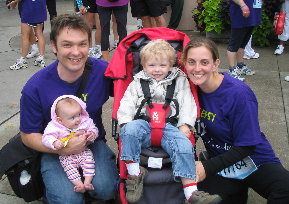At 32 years old Whitney was forced to wear a helmet just to protect her from everyday activities. She couldn't be alone and if she was, she was confined to a wheelchair in case she had a drop seizure. Whitney has epilepsy. She's had the condition for almost half her life and over time it intensified from a benign eye twitch to frequent, sudden seizures that forced her to surrender her independence.
 Whitney is sharing her story for Purple Day, an international awareness day for epilepsy, on Thursday, March 24. For her, it is important to show that epilepsy doesn't just have one face, that there are different types of seizures, multiple forms treatments, and a variety of circumstances that affect how one lives with epilepsy.
Whitney is sharing her story for Purple Day, an international awareness day for epilepsy, on Thursday, March 24. For her, it is important to show that epilepsy doesn't just have one face, that there are different types of seizures, multiple forms treatments, and a variety of circumstances that affect how one lives with epilepsy.
Epilepsy is characterized by brief, on-going seizures, which are caused by over-active electrical signals in the brain. It is the most common, serious neurological condition in the world (it affects over 50 million people worldwide—approximately one in 100), yet it is often a misunderstood by the general public
Whitney began having seizures at 13. "They were simple partial seizures, although I didn't know what to name them at the time," says Whitney. "Every once in a while I would notice my vision would change and for 10-30 seconds everything would go flat, like seeing things in two dimensions instead of three. It was very hard for others to tell I was even having one." Even after multiple visits to the doctors, no one could say what was wrong.
At 19, Whitney had her first tonic-clonic seizure (the kind we are used to seeing in the movies, where a person falls to the ground and shakes). As a result, she was referred to the Epilepsy Clinic at the Krembil Neuroscience Centre, TWH, and diagnosed with epilepsy.
After the diagnosis, her epilepsy was largely under control, with the exception that she had to try different medications to find the right balance. She went off to university, met and married her husband Richard, started a family and worked as a marketing copy writer. At the epilepsy clinic, her doctors worked tirelessly to find a medication that would help.
But during her second pregnancy things started changing. The seizures became more frequent and would caused her to fall to the ground with no warning. Unable to predict or control the seizures, Whitney had to take drastic measures to protect herself and her family.
"I had to start wearing a helmet, even when I left the house. It was just not safe for me—I went through quite a few helmets. I could never be left alone, I couldn't take care of my kids, I had to stop working, and my husband had quit his job to look after all of us. It was traumatic and on top of it I felt guilty. I had no independence and no quality of life."
Throughout this difficult time she credits her husband, Richard, for holding things together. "Epilepsy didn't just affect my life; it was my whole family's life. Richard was wonderful and the services of Epilepsy Toronto and the hospital were invaluable."
Her team of nurses and doctors at TWH continued to look for answers to get her seizures under control. After spending time in the Epilepsy Monitoring Unit, specialists determined that Whitney was a candidate for surgery. For some epileptics, seizures are caused by a scar of lesion on the brain. If that injured area of the brain can be removed, there is strong likelihood that seizures can be reduced or even eliminated.
The road to surgery and recovery was challenging and Whitney faced many struggles with her health. Her neurosurgeon, Dr. Taufik Valiante, removed a lesion the size of a tangerine. Following the surgery he talked to Whitney about her expectations and prepared her for the reality that she would still have seizures.
Whitney waited for her first post-surgery seizure. But since her surgery, she has not had a single seizure. She knows there are no guarantees and that her seizures could come back any day, but she is no longer waiting.
"I feel like I have my life back. Everyday is one more day being seizure-free. Even if the seizures come back, the time I have had without them has been worth it. I can walk up the stairs, take part in my children's bedtime routine. For the first time in a long time, I feel part of my family again."
For more information about Purple Day or to support epilepsy research and treatment, please visit www.tgwhf.ca/sites/purpleday.
